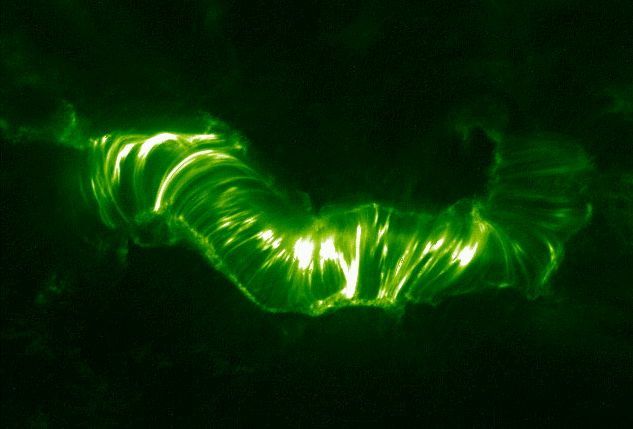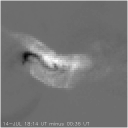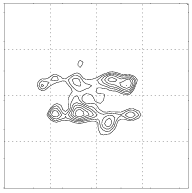
On July 14 of this year, a truly memorable flare and coronal mass ejection took place. We have already written two Yohkoh science nuggets on different aspects of this event( [1], [2]) and here we consider the remarable (unprecedented!) hard X-ray observations from Yohkoh HXT. By way of introduction, here is a TRACE image of the coronal arcade that developed:

One can also get background on this event from the appropriate APOD ("Astronomy Picture of the Day") page about this flare, or from the TRACE Images and Movies page. The picture above covers a large area on the Sun - this event was unusually large physically, as well as powerful energetically, and it produced a colossal coronal mass ejection that had strong terrrestrial effects. The warming of the Earth's upper atmosphere apparently led (informal reports only thus far) to the loss of the ISAS spacecraft ASCA, an X-ray astronomy observatory. Thus we are very concerned about the high-energy aspects of such a flare, and turn to the hard X-ray imaging data.
The hard X-ray imager on board Yohkoh works differently from telescopes with focusing optics (lenses or mirrors) - see the HESSI project for modern links that explain this sort of thing. In a word, such a telescope suffers from a major problem: The only available imaging technology, that of shadow masks, produces images that may have high resolution, but only with low contrast. This is just in the domain where the contrast of the Sun can be compared with black vs. white!
This flare, however, probably because of its nice regularity - that is, the arcade structure seems quite uniform - gave us wonderfully complicated and meaningful HXT images. The image on the left below reminds us of what SXT saw; the image on the right shows HXT's discovery:

|

|
Left:
A difference image showing (bright) the extended arcade as seen in soft
X-rays.
This is a top-down view, so that the basically circular loops that form
the cylinder look more or less like straight lines, some tilted (sheared)
relative to others.
The dark S-shaped feature is the pre-flare sigmoid structure that disappeared
as the flare developed.
Right:
An HXT image from its high-energy band, 53-93 keV.
This image does not exactly match in time, but its configuration is
clear: HXT sees the two ribbons very well indeed, although with resolution
not quite as good as that of TRACE!
Click on the right-hand image for a much bigger display of six images
taken at different times (see the
standard "Neupert Effect" plot
for an orientation into the flare development with time).
The HXT image above shows directly that non-thermal electrons excite the flare ribbons. If HXT had adequate resolution, we think that a flashing and twinkling array of tiny, intense hard X-ray sources would flicker along the ribbons as the point of flare energy release propagated through its coronal reservoir. Even with data of this resolution, we look keenly forward to matching features with soft X-ray and EUV observations. This flare almost surely gives us a chance to discuss some of flare theory's hard questions - what is the 3D coronal structure, and how does its evolution accelerate non-thermal particles?
September 15, 2000